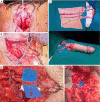Narrative review of the history of microsurgery in urological practice
- PMID: 33968665
- PMCID: PMC8100848
- DOI: 10.21037/tau-20-1441
Narrative review of the history of microsurgery in urological practice
Abstract
The clinical need for magnified visualization during surgery spurred the evolution of microscope and microsuture technology. Innovative surgeons across various surgical specialties recognized the importance of utilizing and advancing these technologies. Operative microscopy allows human dexterity to perform beyond direct visual limitations. Microsurgery started in otolaryngology and ophthalmology, became popular in reconstruction and transplantation, and was then adopted in urology. Microsurgery in urology involves renal and penile revascularization, penile transplantation and free flap phalloplasty, testicular autotransplantation, reproductive tract reconstruction of the vas deferens and epididymis, varicocele repair, and sperm retrieval. By examining the peer reviewed and lay literature, this review discusses the history of microsurgery and its subsequent development as a subspecialty in urology.
Keywords: Urology; microsurgery; phalloplasty; transplantation; vasovasostomy.
2021 Translational Andrology and Urology. All rights reserved.
Conflict of interest statement
Conflicts of Interest: All authors have completed the ICMJE uniform disclosure form (available at http://dx.doi.org/10.21037/tau-20-1441). The authors have no conflicts of interest to declare.
Figures









References
-
- Nylen COS. Något om de senaste 25 årens utveckling inom klinisk vestibularforskning, särskilt rörande labyrintfistelsymtom och lägenystagmus. Uppsala, Leipzig, A.-b: Lundequistska bokhandeln; 1942.
-
- Berland T, Perritt RA. Living with your eye operation. New York: St. Martin's Press, 1974.
-
- Swolin K. Contribution to the surgical treatment of female sterility. Experimental and clinical studies. Acta Obstet Gynecol Scand 1967;46 Suppl:14-20. - PubMed
Publication types
LinkOut - more resources
Full Text Sources
Medical
